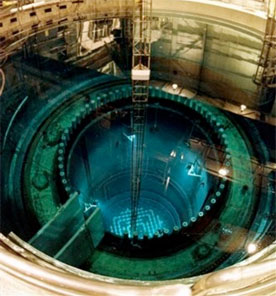Blog Post
Capturing and Distributing Waste Heat From Power Generation

The majority of our electricity in the United States is generated by using a heat source to boil water and produce high-pressure steam, which then spins a steam turbine hooked up to a generator. To generate this steam, our utility companies burn fossil fuels like coal and natural gas, or--as with Vermont Yankee--they rely on the heat of nuclear fission. (Only hydropower, wind, and solar electricity generation do not rely on a heat source and production of steam.)
Unfortunately, when we use steam to generate electricity, only about a third of the energy in the steam is productively used; the rest becomes waste heat that utility companies have to get rid of. This is why, even though we talk about electric baseboard heat being 100% efficient, it isn't really 100% efficient (as was pointed out in a letter to the editor after last week's column). Electric heat is only 100% efficient at it's point of use.
Power plants use cooling towers to dump this heat into the surrounding air, or they draw water from a nearby river or lake to cool the steam and steam condensate directly. Both processes use huge amounts of fresh water; power plants are by far the largest consumer of fresh water in the U.S.--more than irrigation and municipal water use combined. And when surface waters are used for cooling, this waste heat raises the temperature of that water, as occurs in the Connecticut River below Vermont Yankee--a process that can harm fish and other aquatic organisms.
The waste of energy represented by this practice does not make sense. A far better approach is to capture waste heat from power plants and distribute it to heat buildings and carry out heat-intensive industrial processes. This is what combined heat and power (sometimes called co-generation) and district heating are all about.
In a combined heat and power (CHP) plant, after the high-pressure steam spins the steam turbine to generate power, it passes through a heat exchanger where the heat is captured and transferred to water. This hot water (usually at about 200 degrees F) can then be distributed to buildings through a network of buried, insulated pipes. Instead of capturing only about a third of the source energy from the coal, natural gas, or enriched uranium (33% efficiency), total efficiencies with CHP and district heat can be as high as 90%. In warmer months, this heat source can also be used, though absorption cooling, to generate chilled water, which can be distributed for air conditioning.
Most of the CHP systems in the U.S. today are in our largest cities, including Boston, New York, and Philadelphia, and at university and medical campuses. Locally, the Brattleboro Retreat has a CHP plant and district heating system.
SUPPORT INDEPENDENT SUSTAINABILITY REPORTING
BuildingGreen relies on our premium members, not on advertisers. Help make our work possible.
See membership options »One reason that the waste heat from power plants is rarely used in the U.S. is that, since the 1940s, we've built almost all of our power plants away from population centers--where they'll be out of sight and their pollution won't directly bother most residents.
With modern pollution-control equipment and increasing use of natural gas, power plants are increasingly being built in more populated areas where we can more easily use the waste heat.
Another reason we haven't done much with CHP and district heat is that, until recently, other heat sources have been really cheap. Hard as it is to imagine today, until just a few years ago we were paying less than a dollar a gallon for heating oil; at that price, it was hard to justify the expense and hassle of piping hot water to our buildings.
In Europe, especially Scandinavian countries, where fossil fuels have long been more expensive, CHP plants and district heating have been mushrooming in popularity over the past few decades. More than half of all buildings in Denmark, both commercial and residential, are now heated with district energy systems. During a visit to Sweden last winter, I visited three large municipal systems--all of which were fired with wood chips.
Significant improvements in pipe insulation and leak-detection technology have also boosted the use of district heat in Europe. There are now places in Denmark where 30-inch-diameter pipes carry hot water into cities from power plants as far as 30 miles away with heat loss below 10%.
Next week, we'll take a look at using a renewable energy source to power a CHP plant and an effort by the nonprofit Brattleboro Thermal Utility (BTU), organization (of which I am a board member) to create such a system in Brattleboro.
Published September 14, 2008 Permalink Citation
(2008, September 14). Capturing and Distributing Waste Heat From Power Generation. Retrieved from https://www.buildinggreen.com/news-article/capturing-and-distributing-waste-heat-power-generation



Add new comment
To post a comment, you need to register for a BuildingGreen Basic membership (free) or login to your existing profile.